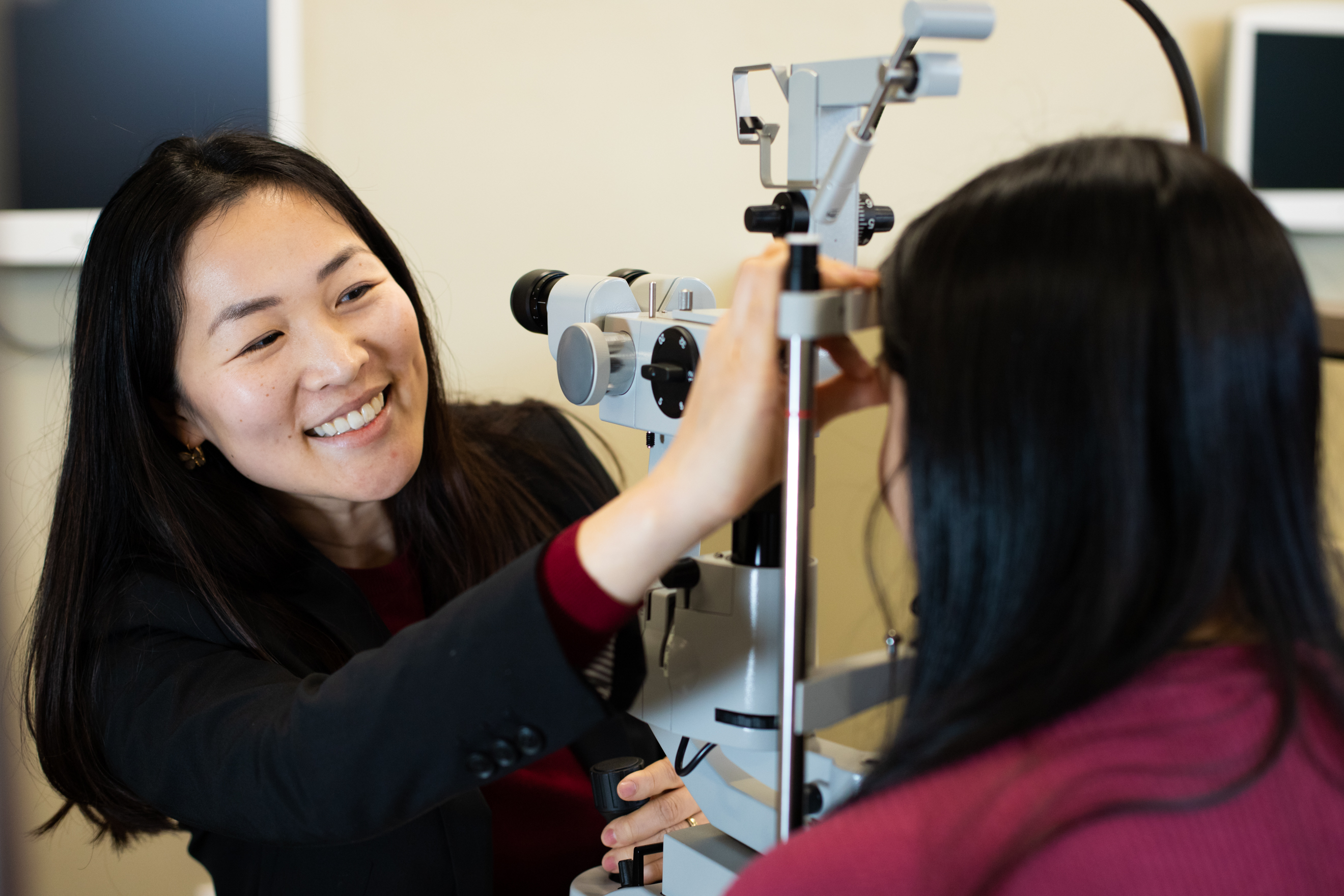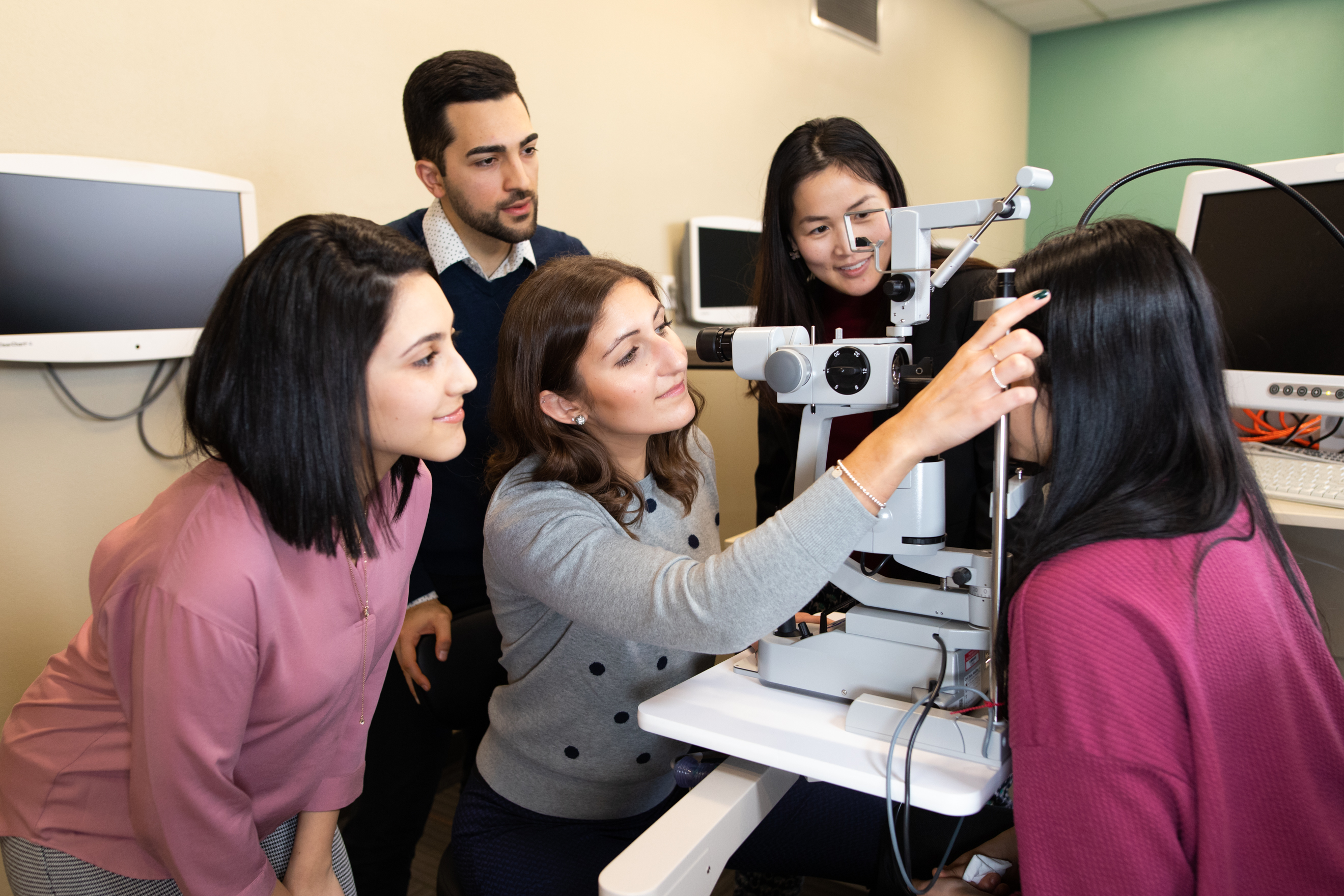How to Become an Optometrist: A Step-by-Step Guide
Become an optometrist at Pacific and spend as much time in the clinic as you do in the classroom with our 75-year history of leading the future of optometry.
Applications for optometry school at Pacific University open this summer through OptomCAS! Inquire today and speak with an expert admissions counselor to begin your optometry career.
High job satisfaction, consistent demand, and an average salary of $124,000 make optometry a rewarding and fulfilling healthcare career. As doctors who study and diagnose eye disorders, optometrists are required to attend and graduate from optometry school, a rigorous four-year optometry doctorate (OD) program that includes detailed classroom instruction and in-clinic job training.
A career in optometry is so much more than a lifetime of performing comprehensive eye exams.
Instead, optometrists identify disease, treat and facilitate rehabilitation for eye problems, and provide essential wellness care that greatly enhances the quality of life for everyone from toddlers to the elderly.
Whether you’re a prospective undergraduate student or an optician ready to take the next step in your career, we’ve got the steps you need to become an optometrist and start helping those in need.
OPTOMETRY SCHOOL PREREQUISITES
Step 1: Explore pre-optometry degree paths.
Application requirements vary between optometry schools – some require a bachelor's degree while others do not – but the strongest candidates all have one thing in common: successful completion of prerequisite courses.
These courses, which emphasize math and science, form the foundation for the material that is taught while studying to become an optometrist.
While programs like biology and chemistry are popular choices for those interested in optometry school, specialized pre-optometry degree paths mean that you can prepare for your optometry application while pursuing other degrees you may be passionate about.
Submitting your application without a bachelor’s degree? No problem!
Pacific’s accelerated Bachelor of Science in Vision Science program allows qualified optometry school applicants without an undergraduate degree to earn their bachelor’s upon successful completion of the doctoral program’s first year.
This means you can graduate on time without having to go back to fulfill any general undergraduate degree requirements outside of the program prerequisites.
Optometrists vs ophthalmologists: what’s the difference?
While both optometrists and ophthalmologists are doctors who specialize in eye care, the treatments for which they are qualified are very different.

Optometrists focus primarily on outpatient care, diagnosing vision problems and managing rehab after eye-related trauma. They only need to have attended optometry school to practice and generally work in private practice.
Ophthalmologists are medical doctors — which requires going to medical school and completing a residency — who perform eye surgery and inpatient medical procedures to treat chronic and immediate issues. They are often found in hospitals.
Both careers allow for personal interactions with patients and room for advancement, but the type of schooling required are very different.
We encourage you to explore Pacific’s pre-med and pre-optometry tracks to see what’s right for you.
Step 2: Prepare your optometry school application.
Every OD program is unique, but many share a few key application requirements and the strongest applications are those that demonstrate interest in the profession both in and outside of the classroom. Here’s what we recommended to make your application stand out.
-
Take the OAT. The Optometry Admission Test is a national test that gauges how comfortable an applicant is with the kind of material that will be covered in optometry school.
However, Pacific also accepts Graduate Record Examination (a general knowledge exam that many graduate schools compare against admissions applications) test scores in lieu of the OAT.
-
Participate in pre-professional clubs. These clubs — especially pre-optometry clubs, if your school has them — are a great way for prospective students to share resources and compare programs.
Clubs are also often visited by representatives from graduate OD programs, and are an easy way to get your application questions answered.
-
Volunteer and observe. While not required by all OD programs, some amount of time spent in a clinical environment shadowing optometrists demonstrates a passion for optometry that can make the difference between acceptance and the waitlist.
Pacific recommends 10 hours, but the more you can spend in the healthcare setting the stronger your application becomes.
As a nontraditional student, I felt beyond supported and celebrated for my unique background.
– Nikole-Marie Espino '26
Step 3: Explore programs and apply with OptomCAS.
Currently, there are currently 24 OD programs in the United States and Puerto Rico that accept optometry school applications through the Optometry Centralized Application Service.
That means there are 24 unique programs complete with their own experiences and curriculum. How do you choose?
Look for OD programs with demonstrated experience putting students in the workplace.
No amount of classroom instruction can replace hands-on training alongside skilled professionals, and with Pacific’s 75 years of experience placing prospective optometrists in EyeClincs throughout Oregon and southern Washington, you are guaranteed to graduate with real-world job training.

The fourth year of Pacific’s OD program is spent entirely in the clinic, giving you access to expert, hands-on instruction every single day.
Keep an eye out also for scholarships. Optometry school is an expensive endeavor, so finding financial aid where you qualify can make the decision to attend that much easier.
Due to Pacific’s long history in the Oregon community, we are proud to offer a range of internally and externally-funded scholarships available to optometry school students.
Of course there is so much more to mention, but the best way to explore the programs on your list is to get in touch with a school’s admission counselor who can help arrange campus tours, meetings with current students, and answer any and all questions you may have.
Then, when you’re ready, submit your materials through OptomCAS — you can apply to multiple schools using only one application — and you’ll be that much closer to starting your optometry career.
Step 4: You’re in! Now take advantage.
Congratulations! Getting accepted to optometry school is no easy feat, and you’re about to start a process that will lead to a fulfilling career in optometry.
Making the most of optometry school means a lot more than just attending classes and clinic time, though. Here’s what we recommend to get the most out of your OD program and prepare yourself to become an optometrist.
-
Join clubs. The large number of national, regional, and affinity clubs and organizations associated with optometric professionals is always growing.
Whether you’re interested in helping underserved populations or are looking to network with working optometrists, Pacific hosts them all.
-
Participate in research. Vision science research has never been more accessible for students in optometry programs, and taking part in clinical studies can give you a direct look at the kinds of work optometrists can do outside of the exam room.
Pacific’s Vision Performance Institute and Childhood Atropine for Myopia Progression (CHAMP) Study are both available to optometry students to augment their classroom experience.
-
Get out in the community. One of the core tenets of Pacific’s optometry program is community care, and students are encouraged to participate in that mission in any way they can.
One unique aspect of this care is the College of Optometry EyeVan, a mobile exam room and vision care center that aims to serve those in the Pacific Northwest community who may not have easy access to eye care.
From my first encounter in undergrad to interview day, every interaction I had with Pacific was warm and welcoming.
– Amber Bui '26
Step 5: Continue your education with residencies.
After successfully passing your National Board of Examiners test (Pacific routinely has a first-time pass rate higher than the national average) the world of optometry opens up!
Some graduates choose to enter private practice or work in hospital settings. Others, however, choose to continue their education through research and residencies, honing their special interests.
Pacific’s connections to residency opportunities across the country allow graduates to refine their passion for optometry in ways that create intense and expert specializations.
Combined with our continuing education programs to help graduates retain their licensure, these programs ensure that — beyond the scope of classwork and clinic time — Pacific graduates are supported so that they can help their communities as best they can.
Applications for Pacific’s College of Optometry open this summer! Get the answers to your questions about application materials, prerequisites, reference letters, and more by reaching out to an admissions counselor today.


